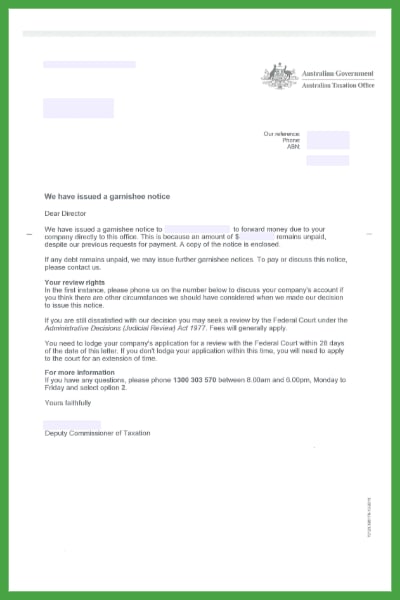Help!
I received a Garnishee Notice for unpaid ATO tax or other debts.
What are my next steps?
If you have received an ATO tax Garnishee Notice directly or a garnishee notice from another creditor via a court order, you're not alone and you're not without options.
Step one is to understand the impact of the garnishee and the options available to resolve. It is important to seek professional advice to help you respond appropriately to the garnishee notice whether it is from the ATO for tax or from another creditor through a court order.
Our team is ready to help you. Reach out to us today for a free consultation. We can talk about your situation and look at all of the available solutions together.

Unsure what a garnishee notice means for you?
Take control of the situation.
Let us help you understand and act on your garnishee order.
A Garnishee Notice is a legal tool that the ATO can use directly to recover unpaid tax debts, or it may be arranged by another creditor through a court process.
It allows them to instruct a third party, like your bank, employer or customers to send money directly to the ATO or other creditors from your debtors, wages, bank accounts or business income. This can happen without your consent, and often without warning.
Acting quickly is key: the sooner you seek qualified advice, the better your chances are of negotiating and exploring options and resolving the issue.
The ATO can send a Garnishee Notice to recover a tax debt owed by either an individual, business, company or trust. For business directors, a Garnishee Notice may be accompanied by a Director Penalty Notice (DPN), which seeks to hold you personally liable for unpaid company tax debts such as GST, PAYG, and compulsory superannuation.
Yes. There are two main types of ATO tax Garnishee Notices you may receive directly. These are issued by the ATO without needing to go through the courts. Separately, other creditors may pursue garnishee orders through a legal court process. The two types of ATO tax garnishee notices that we commonly see are:
A one-off garnishee notice (referred to as a Point in Time Garnishee):
This is a one-time payment to be made from the third party to the creditor. For example, a bank may be directed to pay a specific amount from your bank account balance to the creditor.
This type of notice is mostly issued to access a lump sum of money, such as funds in an account or proceeds of sale. The amount recovered must be the lesser of either the full tax debt or 30% of the balance of the lump sum.
A continuing garnishee notice (referred to as Enduring):
This is an ongoing payment arrangement that requires the third party to make payments at regular intervals to the ATO until the nominated debt listed on the garnishee notice is cleared. For example, a debtor, customer or a client may be directed to garnishee a percentage (sometimes 100%) of the money owed to a company or business and pay it directly to the ATO. This can severely impact the businesse’s cash flow and it’s ability to meet ongoing trading obligations.
Take care of your mental well-being.
Dealing with financial difficulties can be overwhelming and personally challenging. It’s not an easy journey.
Prioritising your mental health is essential to navigate through these tough times and come out stronger.
Don't hesitate to seek support when needed.
Consult your doctor or contact the following organizations if you require immediate assistance.

 |  |  |  |





